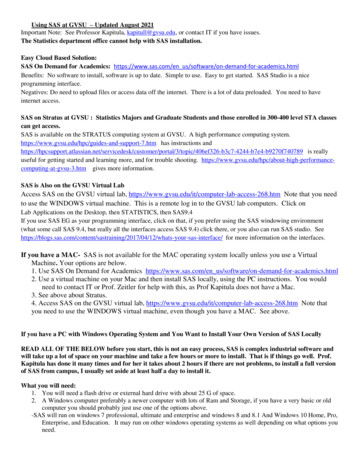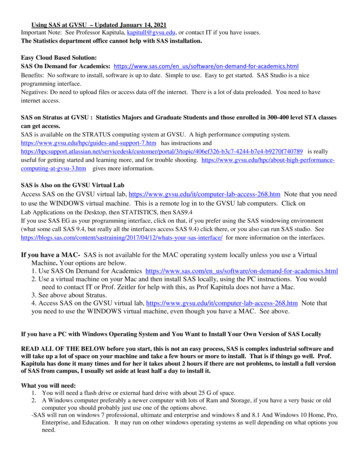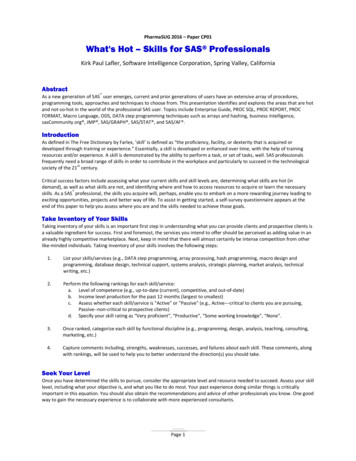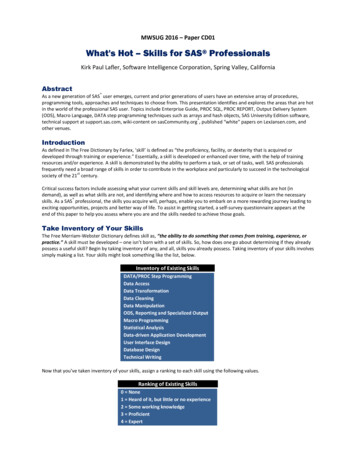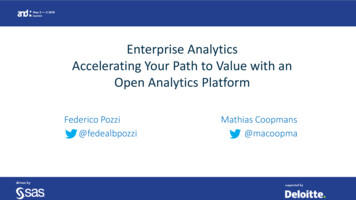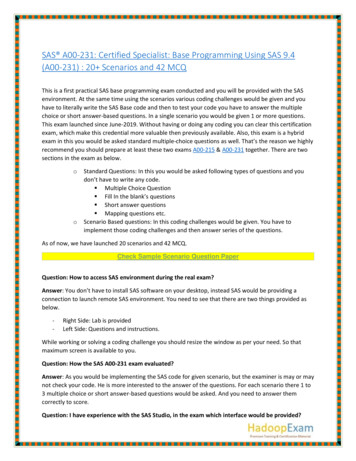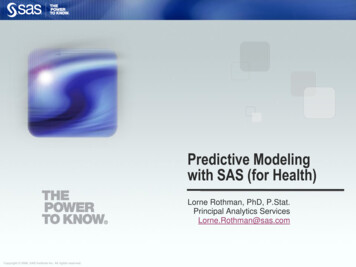
Transcription
Predictive Modelingwith SAS (for Health)Lorne Rothman, PhD, P.Stat.Principal Analytics ServicesLorne.Rothman@sas.comCopyright 2006, SAS Institute Inc. All rights reserved.
Overview What is Predictive Modeling? Purpose, challenges, and methods Examples The North Carolina Low Birth Weight Data Data & Variable Preparation Oversampling, Missing Values, Data splitting & dimensionreduction Binary Target Modeling Decision Trees with HPSPLIT Logistic Regression with LOGISTIC Comparing ROC curves Continuous Target Modeling Model selection with GLMSELECT Generalized Linear Predictive Modeling Gamma regression model selection with HPGENSELECTCopyright 2006, SAS Institute Inc. All rights reserved.
What is PredictiveModeling?Copyright 2006, SAS Institute Inc. All rights reserved.
Purpose of Predictive Modeling To Predict the Futurex To identify statistically significant attributes orrisk factorsx To publish findings in Science, Nature, or theNew England Journal of Medicine To enhance & enable rapid decision making atthe level of the individual patient, client,customer, etc.x To enable decision making and influence policythrough publications and presentationsCopyright 2006, SAS Institute Inc. All rights reserved.
Data DelugeCopyright 2006, SAS Institute Inc. All rights reserved.
Challenges: Rare EventsOKRareConditionCopyright 2006, SAS Institute Inc. All rights reserved.
Methodology: Empirical ValidationCopyright 2006, SAS Institute Inc. All rights reserved.
Predicting the Future with Data SplittingTrainingTESTValidation20002001 Models are fit to Training Data, compared andselected on Validation and tested on a future Testset.Copyright 2006, SAS Institute Inc. All rights reserved.
Methodology: Diversity of AlgorithmsCopyright 2006, SAS Institute Inc. All rights reserved.
Jargon Target Dependent Variable. Inputs, Predictors Independent Variables. Supervised Classification Predicting class membership withalgorithms that use a target. Scoring The process of generating predictions on new datafor decision making. This is not a re-running of models but anapplication of model results (e.g. equation and parameterestimates) to new data. Scoring Code programming code that can be used toprepare and generate predictions on new data includingtransformations, imputation results, and model parameterestimates and equations.Copyright 2006, SAS Institute Inc. All rights reserved.
Examples SAS Discharge Disposition and Length of Stay Modeling for Hospitals Length of stay: Survival modeling to predict ‘target’ discharge date up to 2 days prior todischarge for patients who end up going home with care or without care. Discharge disposition: Predict discharge disposition 2 days prior to patient dischargefor those patients who will go home with home care and those who will go home withouthomecare. Data: Use daily in-hospital data from admissions, OR, DI, pharmacy, lab tests, etc. toscore patients daily.Predicting End Stage Renal FailureSurvival modeling to predict probability of developing End Stage Renal Disease givenpatient attributes and kidney function measures.What makes these predictive models? Same algorithms as employed in inferential statistics, but different methodology andmodeling purpose—to score individuals in near real time and use results for rapidand preemptive decision making.Copyright 2006, SAS Institute Inc. All rights reserved.
The North Carolina Birth Records Data North Carolina Birth Records from North CarolinaCenter for Health Statistics: 122,550 from 2000, and120,300 from 2001. 7.2% low birth weight births ( 2500 grams) excludingmultiple births. Data contains information on parents ethnicity, age,education level and marital status. Data contains information on mothers health conditionand reproductive history. 45 potential predictor variables for modeling.Copyright 2006, SAS Institute Inc. All rights reserved.
Scenario: Early Warning System for Birth WeightPREDICTORS Parent socio-,eco-, demo- graphics, health and behaviour Age, edu, race, medical conditions, smoking, drinking etc. Prior pregnancy related data # pregnancies, last outcome, prior pregnancies etc. Medical History for pregnancy Hypertension during pregnancy, eclampsia, incompetent cervix,etc. Obstetric procedures Amniocentesis, ultrasound, etc. Events of Labor Breech, fetal distress etc. Method of delivery Vaginal, c-section etc. New born characteristics congenital anomalies (spinabifida, heart), APGAR score, anemiaCopyright 2006, SAS Institute Inc. All rights reserved.
Beware of Temporal Infidelity . Obstetric procedures Parent socio-,eco,- demo- graphics andbehaviour Prior health and pregnancy related dataTimeCopyright 2006, SAS Institute Inc. All rights reserved. Medicalhistory forthispregnancy Events of Labor Method of delivery New born characteristics
Data & VariablePreparationCopyright 2006, SAS Institute Inc. All rights reserved.
Preparing the Modeling Datatime rangeattributeslatency period target windowtimestartdateCopyright 2006, SAS Institute Inc. All rights reserved.Tmaxrelative time0targetdateenddate
Oversample Rare Events SURVEYSELECT is used to sample 7.5% of non-events and 100% of events. Data must be sorted by the target prior to oversampling.Copyright 2006, SAS Institute Inc. All rights reserved.
Create Missing Indicators Create missing indicators to capture associations between missingness andthe target in development data. The process is repeated for Test data. This step is unnecessary for Decision Trees as they accommodate missingvalues directly.Copyright 2006, SAS Institute Inc. All rights reserved.
Partition Data for Empirical Validation SURVEYSELECT is used to partition data into Training (67%) and Validation (33%) sets. The OUTALL option provides one dataset with a variable, SELECTED that indicatesdataset membership. For class targets, stratification on the target, LBWT ensures equal representation of lowbirth weight cases in training and validation sets. Since HPSPLIT and HPGENSELECT procedures do not accept separate train andvalidate sets, the dataset output from SURVEYSELECT will be used before physicallysplitting into train and validation data.Copyright 2006, SAS Institute Inc. All rights reserved.
Impute Missing Values STDIZE will replace missing values (REPONLY) and is applied to the Trainingdata. The OUTSTAT option saves a dataset to be used to insert results (score) intoValidation and Test sets. The METHOD IN (MED) uses the imputation information from the trainingdata to score the Validation and Test data. Imputation is unnecessary for Decision Trees as they accommodate missingvalues directly.Copyright 2006, SAS Institute Inc. All rights reserved.
Cluster Variables to Reduce Dimensions Cluster variables on training data to reduce collinearity prior to modeling. E.g.PROC VARCLUS.Copyright 2006, SAS Institute Inc. All rights reserved.
Collapse Categorical Variables to Reduce Dimensions Variables RACEMOM and RACEDAD contain 9 and 10 levels respectively. Use a Decision Tree model to optimally collapse many possible combinations ofthese attributes to a single 6-level variable using training data. This step is unnecessary if you are using a decision tree as a predictive model.Copyright 2006, SAS Institute Inc. All rights reserved.
Binary Target ModelingCopyright 2006, SAS Institute Inc. All rights reserved.
New Modeling Routines in SAS/STAT: Decision Trees usingHPSPLIT In SAS 9.4 some of the high performance procedures used in EnterpriseMiner software for data mining are now available in SAS/STAT (nowcalled version 14.1). Procedures support parallel processing and are designed to run in adistributed computing environment (across multiple servers for highspeed computing). Procedures are available to run on a single machine or server. They arenow shipped with SAS/STAT at no additional cost. In this section we will feature HPSPLIT for decision trees using a binarytarget and in a later section, HPGENSELECT for generalized linearmodels and mixture distributions using a continuous target.Copyright 2006, SAS Institute Inc. All rights reserved.
Build Decision Trees using HPSPLIT The program fits a CART-like decision tree to low birth weight data: with surrogates, GINI splittingcriterion, Cost-complexity pruning (Breiman et al.), and data splitting (PARTITION) from a singledevelopment dataset using a flag variable (SELECTED) that indicates train/validate membership.CHAID-like and machine learning-like trees are also possible.Tree plots are subset using a ZOOMEDTREE option. Node details are printed using a NODESoptions.Minimum leaf and class variable sizes, maximum branches, and maximum depth are set usingMINLEAFSIZE, MINCATSIZE, MAXBRANCH, and MAXDEPTH options.Missing values are assigned to the branch with largest sample size (ASSIGNMISSING POPULAR).Data Step scoring code is saved to a file using the CODE statement, available in PROCs: GENMOD,GLIMMIX, GLM, GLMSELECT, LOGISTIC, MIXED, REG, HPSPLIT, HPGENSELECT and others Copyright 2006, SAS Institute Inc. All rights reserved.
Cost-Complexity Pruning with the PRUNE Statement Though the full tree has over 80 leaves, Cost-Complexity Pruning on misclassificationrate yields a 16 leaf tree that minimizes misclassification rate.Copyright 2006, SAS Institute Inc. All rights reserved.
The Final Tree Nodes and leaves areidentified with numbersand letters. The width of the curvesare proportional to amountof data passing througheach part of the tree. Red indicates low bwtclassification while blueindicates normal weight.Copyright 2006, SAS Institute Inc. All rights reserved.
Plot Tree Sections Using the ZOOMEDTREE option Classifications using a cutoff of0.5 are given at the top of eachnode (e.g. Node T is classifiedas low birth weight while NodeU is classified as normalweight). Samples sizes forTrain/Validate data, as well asproportions of target 1 in eachare shown. Red indicates low bwtclassification while blueindicates normal weight.Copyright 2006, SAS Institute Inc. All rights reserved.
Display Leaf Rules using the NODES Option etc etc. Rules details for all leaves are reported. Asterisk indicates selected target level.Copyright 2006, SAS Institute Inc. All rights reserved.
Explore Variable Importance Race of mother and father as well as marital status and smoking behavior are the topmost important variables.Copyright 2006, SAS Institute Inc. All rights reserved.
Model Assessments Training and Validation assessment measures and overlayed ROC curves are output.Copyright 2006, SAS Institute Inc. All rights reserved.
Score Data using HPSPLIT Scoring CodeEtcEtc Validation and Test data are scored using Decision Tree Scoring code. Probabilities can be adjusted for oversampling (P 1ADJtree) if desired though this is notrequired for ROC curve assessments. Validation and Test scores from the tree model are match-merged back to thecorresponding imputed sets to be used for regression (not shown here).Copyright 2006, SAS Institute Inc. All rights reserved.
Select Regression Models and Score The SCORE statements allows for scoring of new data (Validation and Test) and adjusts oversampled data back to thepopulation prior (PRIOREVENT 0.072). The ALLVAL and ALLTEST sets containing decision tree predictions are supplied in the first regression run. The samedatasets are re-scored (SCO VALIDATE, SCO TEST), and prediction variables renamed, so that predictions for all fourmodels are in the same set for comparisons.Copyright 2006, SAS Institute Inc. All rights reserved.
Early Warning Regression Output, for example. In general, predictive models fit tolarger datasets tend to have moreparameters than more theoreticallyinformed explanatory models inhealth. Odds ratios for previous prematurebabies (PRETERM), renal disease(RENAL), and chronic hypertension(HYPERCH) and are particularlylarge. The collapsed version of mother andfather race from an initial decisiontree (TREE RACE) appears in themodel.Copyright 2006, SAS Institute Inc. All rights reserved.
Model Assessments for Binary Targets110TPPredicted**0FNAPAccuracy (TP TN)/nSensitivity TP/APSpecificity TN/ANFPTNANPPPNn** - Where Predicted 1 (Pred Prob Cutoff)Copyright 2006, SAS Institute Inc. All rights reserved.Lift (TP/PP)/π1
Assessment Charts for Binary TargetsROC ChartsSELiftLift Charts1-SPDepthExplore measures across a range of NFPTNCopyright 2006, SAS Institute Inc. All rights reserved.
Receiver Operator Curves1.00.0weak model0.01.0strong model A measure of a model’s predictive performance, or model’s ability to discriminate betweentarget class levels. Areas under the curve range from 0.5 to 1.0. A concordance statistic: for every pair of observations with different outcomes (LBWT 1,LBWT 0) AuROC measures the probability that the ordering of the predicted probabilitiesagrees with the ordering of the actual target values. Or the probability that a low birth weight baby (LBWT 1) has a higher predicted probabilityof low birth weight than a normal birth weight baby (LBWT 0).Copyright 2006, SAS Institute Inc. All rights reserved.
Predict the Future with Data SplittingTrainingTESTValidation20002001 Models are fit to Training Data, compared andselected on Validation and tested on a future Testset.Copyright 2006, SAS Institute Inc. All rights reserved.
Assess Models using ROC Curves The dataset with all four predictions (SCO VALIDATE) is supplied to PROC LOGISTIC. The ROCCONTRAST statements provides hypothesis tests for differences between ROCcurves, for model results specified in the three ROC statements. To generate ROC contrasts, all terms used in the ROC statements must be placed on themodel statement. The NOFIT option suppresses the fitting of the specified model. Because of the presence of the ROC and ROCCONTRAST statements, ROC plots aregenerated when ODS GRAPHICS are enabled. The identical process is repeated with the scored Test set, SCO TEST. Can the modelpredict the future?Copyright 2006, SAS Institute Inc. All rights reserved.
Compare ROC Curves on Validation DataCopyright 2006, SAS Institute Inc. All rights reserved.
Compare AuROC Curves on Validation DataCopyright 2006, SAS Institute Inc. All rights reserved.
Compare ROC Curves on Test DataCopyright 2006, SAS Institute Inc. All rights reserved.
Compare AuROC Curves on Test DataCopyright 2006, SAS Institute Inc. All rights reserved.
Compare Lift Charts on Test DataAll Effects Regression Individuals in the top 5% most likelyto have low birth weight babies areabout 3.5 x more likely than averageto have a lbwt baby.Early Warning Decision Tree Individuals in the top 5% most likelyto have low birth weight babies areabout 2.5 x more likely than averageto have a lbwt baby.Copyright 2006, SAS Institute Inc. All rights reserved.
Continuous TargetModelingCopyright 2006, SAS Institute Inc. All rights reserved.
Continuous Target: Birth WeightCopyright 2006, SAS Institute Inc. All rights reserved.
Build Regression Models with GLMSELECT GLMSELECT fits continuous target models (under GLMassumptions) and can process validation and test datasets, orperform cross validation for smaller datasets. It can also performdata partition using the PARTITION statement. GLMSELECT supports a class statement similar to PROC GLMbut is designed for predictive modeling. Selection methods include Backward, Forward, Stepwise, LARand LASSO.Copyright 2006, SAS Institute Inc. All rights reserved.
Least Angle Regression Standardize inputs and response. All coefficients are zero. The predictor, X1 that is most correlated with the current residual (makes the leastangel with the residual) is determined and a step is taken in the direction of thispredictor (X1 is added to model). The length of this step (the coefficientmagnitude) is chosen so that some other predictor, X2 and the current predictedresponse have the same correlation with the current residual (equiangular). At this point, the predicted response moves in the direction that is equiangularbetween (equally correlated with) these two predictors. Moving in this directionensures that these two predictors continue to have a common correlation with thecurrent residual. The predicted response moves in this direction until a third predictor, X3 has thesame correlation with the current residual as the two predictors already in themodel. A new direction is determined that is equiangular between these threepredictors and the predicted response moves in this direction until a fourthpredictor joins the set having the same correlation with the current residual. This process continues until all predictors are in the model.Copyright 2006, SAS Institute Inc. All rights reserved.
Select Models with GLMSELECT SELECTION LAR requests Least Angle Regression.SELECT determines the order in which effects enter or leave the model. Options include, for example: ADJRSQ, AIC,SBC, CP, CV, RSQUARE and SL. SL uses the traditional approach of significance level. SELECT is not available for LARand LASSO.Models can be tuned with the CHOOSE option to select the step in a selection routine using e.g. AIC, SBC, Mallow’s CP,or validation data error. CHOOSE VALIDATE selects that step that minimizes Validation data error.Copyright 2006, SAS Institute Inc. All rights reserved.
Backward Model Tuning using Validation ASECopyright 2006, SAS Institute Inc. All rights reserved.
Backward Model: Select and Choose using SBCCopyright 2006, SAS Institute Inc. All rights reserved.
LAR Model Tuning using Validation ASECopyright 2006, SAS Institute Inc. All rights reserved.
Assess Final Model GLMSELECT does not provide model diagnostics. The model selected by GLMSELECT can be refit in PROC GLM. PLOTS DIAGNOSTICS requests diagnostic plots. With larger datasets the usermay have to increase the number of allowable plotting points using theMAXPOINTS option.Copyright 2006, SAS Institute Inc. All rights reserved.
PROC GLM ModelEstimates Tuning a model on Validation data error,especially when using a backwardregression does not guarantee that allterms in the final model will besignificant at the 5% level.Copyright 2006, SAS Institute Inc. All rights reserved.
PROC GLM Statistical Graphics Diagnostics ODS GRAPHICS ON andPLOTS DIANGOSTICS.Copyright 2006, SAS Institute Inc. All rights reserved.
Generalize LinearPredictive ModelingCopyright 2006, SAS Institute Inc. All rights reserved.
The Gamma Distribution for Right-Skewed Targets:Charity Donation DataCopyright 2006, SAS Institute Inc. All rights reserved. Donation amount, as is often the casefor monetary or usage outcomes, isright skewed. An alternative to the Lognormal is theGamma Distribution from theExponential Family.
New Modeling Routines in SAS/STAT: Generalized LinearModels and Mixture Distributions using HPGENSELECT Fits Generalized Linear Models by specifying a distribution and linkfunction to enable modeling of count data, rates, and non-normalcontinuous outcomes. Supports model selection routines Backward, Forward, Stepwise selection using significance level LASSO selection Choice of final model using significance level, AIC, SBC Supports mixture distributions Zero Inflated Poisson Zero Inflated Negative Binomial TweedieCopyright 2006, SAS Institute Inc. All rights reserved.
Mixture Models withHPGENSELECT The Tweedie distribution has been used extensively in insurance data modeling asit corresponds to the underlying loss generating process (e.g. total cost of claims).This mixed type distribution results from the mixing of two underlying components- the Poisson and Gamma distributions. In the Zero-Inflated Poisson Model, the population is considered to consist of twotypes of individuals. The first type gives Poisson distributed counts, which mightcontain zeros. The second type always gives a zero count. The ZIP model fits,simultaneously, two separate regression models. One is a logistic model thatmodels the probability of being eligible for a non-zero count. The other models thesize of that count.Copyright 2006, SAS Institute Inc. All rights reserved.
Fit a Gamma Regression to the Charity Donation Data A single development dataset is supplied to the procedure. The PARTITION statementrequests a 67/33% split of this set. A backward regression is run, eliminating terms based on statistical significance. The finalmodel in the backward sequence is chosen using the Schwartz Bayesian Criterion. A Gamma distribution is fit using a log link (though inverse is the canonical link).Copyright 2006, SAS Institute Inc. All rights reserved.
HPGENSELECT Output Fit Statistics aregiven for Trainingand Validation data. The model at step 15 minimizesSBC and is selected.Copyright 2006, SAS Institute Inc. All rights reserved.Estimates andsignificancetests areprovided.
Thank YouLorne.Rothman@sas.comCopyright 2006, SAS Institute Inc. All rights reserved.
Survival modeling to predict probability of developing End Stage Renal Disease given patient attributes and kidney function measures. What makes these predictive models? Same algorithms as employed in inferential statistics, but different methodology and modeling purpose—to scor
